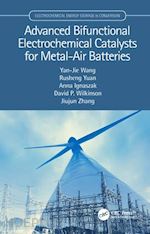Dr. Yan-Jie Wang obtained his M.S. in Materials from North University of China in 2002 and his Ph.D. in Materials Science & Engineering from Zhejiang University, China in 2005. Subsequently, he conducted two and a half years of postdoctoral research at Sungkyunkwan University, Korea, followed by two years as a research scholar at Pennsylvania State University, USA, studying advanced functional materials. In April 2009, he was co-hired by the University of British Columbia, Canada, and the National Research Council of Canada to research advanced materials. During November 2012 and August 2017, he worked as a senior research scientist for the University of British Columbia and Vancouver International Clean-Tech Research Institute Inc. (VICTRII), researching core–shell structured materials. From September 2017, he started as an academic leader in the School of Environment and Civil Engineering at the Dongguan University of Technology. Also, he is an adjunct professor at Fuzhou University in China. Dr. Wang has published 60 papers in peer-reviewed journals, conference proceedings and industry reports. His research interests include electrochemistry, electrocatalysis, polymer materials and nanostructured material synthesis, characterization, and application in energy storage and conversion, biomass engineering, and medical areas. Dr. Rusheng Yuan is a professor at the State Key Laboratory of Photocatalysis on Energy and Environment in the College of Chemistry and Chemical Engineering, Fuzhou University. He received his M.S. in Chemical Technology from North China Institute of Technology in 2002 and his Ph.D. in Chemical Technology from Institute of Coal Chemistry, Chinese Academy of Sciences and China University of Petroleum (East China). He then joined the College of Chemistry and Chemical Engineering, Fuzhou University and was promoted to professor in 2014. His research interest focuses on electrocatalysis and photocatalysis, and their applications in energy and environment. Dr. Anna Ignaszak is an assistant professor at the Department of Chemistry, University of New Brunswick and an adjunct assistant professor in the Institute of Organic and Macromolecular Chemistry at the Friedrich-Schiller University (Jena, Germany, Carl-Zeiss junior professorship holder since May 2012) after completing her appointment as a research associate at the Clean Energy Research Center (CERC), The University of British Columbia (Vancouver, Canada), and as a research associate at the National Research Council of Canada, NRC – Institute for Fuel Cell Innovation (Vancouver, Canada). She has a diverse background in materials for electrochemical energy storage and conversion, electrochemical sensors, functional materials (carbons, composites, metal clusters) and heterogeneous catalysis. The research conducted in her labs in Canada and Germany aims to synthesizing morphology-controlled nano-catalysts and understand the structure-reactivity interplay for the optimum redox activity, electrochemical characterization, and electrode engineering. She also spent several years working in industrial R&D (ABB Corporate Research, Pliva Pharmaceutical Company, Ballard Power Systems Inc.). Dr. David P. Wilkinson is Professor and Canada Research Chair in the Department of Chemical and Biological Engineering at the University of British Columbia (UBC). He previously held the positions of Executive Director of the UBC Clean Energy Research Center, Principal Research Officer and Senior Advisor with the National Research Council of Canada Institute for Fuel Cell Innovation, Director and Vice President of Research and Development at Ballard Power Systems, and Group Leader at Moli Energy. His main research interests are in electrochemical and photochemical devices, energy conversion and storage materials, and processes to create clean and sustainable energy and water. Dr. Jiujun Zhang is a professor at Shanghai University and Principal Research Officer (Emeritus) at the National Research Council of Canada (NRC). Dr. Zhang’s areas of expertise are electrochemistry, photoelectrochemistry, spectroelectrochemistry, electrocatalysis, fuel cells (PEMFC, SOFC, and DMFC), batteries, and supercapacitors. Dr. Zhang received his B.S. and M.Sc. in Electrochemistry from Peking University in 1982 and 1985, and his Ph.D. in Electrochemistry from Wuhan University in 1988. Starting in 1990, he carried out three terms of postdoctoral research at the California Institute of Technology, York University, and the University of British Columbia. Dr. Zhang holds more than 14 adjunct professorships, including one at the University of Waterloo and one at the University of British Columbia.











